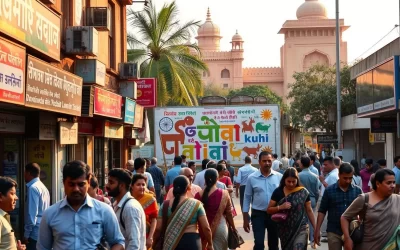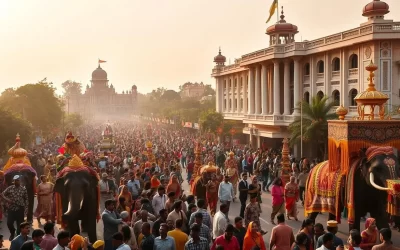As you explore Chandigarh, a Union Territory in India, you’ll uncover a unique linguistic profile that reflects its status as a planned city and the capital of two states.
The city’s language landscape is characterized by a dominant official language, English, despite not being the most widely spoken among residents.
Hindi speakers make up 73.60% of the population, while Punjabi speakers account for 22.03%, creating a multilingual environment.
Understanding this linguistic diversity requires examining the historical development, administrative structure, and cultural influences that shape language use in Chandigarh.
The Linguistic Landscape of Chandigarh
As you explore Chandigarh, you’ll discover a city that stands out for its meticulous planning and linguistic diversity. Chandigarh is one of India’s few cities that was carefully designed, and this characteristic extends beyond its architecture to its administrative and linguistic structures.
Chandigarh as a Planned City
Chandigarh was designed by the renowned architect Le Corbusier to serve as the capital for both Punjab and Haryana states. This planned nature has a significant impact on how languages are officially recognized and used in government functions. The city’s design and administrative structure were intended to support a finite population of half a million within a well-defined site. To prevent urban sprawl, the ‘Punjab New Capital Periphery Control Act, 1952’ was enacted, ensuring the surrounding area maintained its primarily rural character.
Overview of Language Diversity
Chandigarh presents an interesting case in terms of its official language, with English serving as the sole official language despite being spoken by a minority. The city’s linguistic landscape is characterized by its position at the crossroads of Hindi and Punjabi cultural zones, creating a diverse language environment. You will find that despite its relatively small population, Chandigarh maintains a multilingual character, with Hindi, Punjabi, and English serving different functions in various domains.
The language diversity in Chandigarh is a reflection of its unique history and cultural influences. As a union territory, Chandigarh’s language policies are shaped by its administrative status. Understanding the language diversity requires examining both official policies and the practical reality of language use among its residents. This diversity is a hallmark of the city’s identity as one of the union territories in India.
The city’s official language, English, plays a crucial role in government and administrative functions, highlighting the city’s commitment to a specific linguistic identity amidst its cultural diversity.
What is the Official Language of Chandigarh?
You might be curious about the official language used in Chandigarh, a city with a rich linguistic diversity. Chandigarh, as a Union Territory, has a unique linguistic profile shaped by its administrative status and cultural context.
English as the Sole Official Language
Chandigarh is one of the few places in India where English holds the unique position of being the sole official language. This distinction makes it stand out linguistically within the country. Today, English has the status of an official language in several states, including Arunachal Pradesh, Chandigarh, Goa, Manipur, Meghalaya, Mizoram, Nagaland, and Tripura, as well as in some Union Territories like Andaman and Nicobar, Dadra and Nagar Haveli, Daman and Diu, and Pondicherry.
The use of English as the sole official language in Chandigarh primarily affects government administration, official documentation, court proceedings, and formal communication within the territory. Despite being the official language, English is not the most widely spoken language in everyday conversations among Chandigarh residents. The decision to use English was likely influenced by its neutrality in the context of the Punjab-Haryana division and its utility as a link language in administration.
Legal Framework for Language Status
The legal framework establishing English as the official language of Chandigarh stems from its special administrative status as a Union Territory and the capital of two states with different linguistic majorities. This framework is crucial in understanding the rationale behind the language policy in Chandigarh. The designation of English as the sole official language helps navigate the complex multilingual environment, ensuring effective governance and administration.
Similar to Chandigarh, several other Union Territories and northeastern states have also designated English as an official language, often to navigate complex multilingual environments. This approach highlights the practical considerations behind language policy decisions in diverse regions.
In conclusion, Chandigarh’s language policy, with English as its sole official language, reflects its unique administrative and cultural context. Understanding this aspect provides insight into the broader linguistic landscape of the region.
Major Languages Spoken in Chandigarh
In Chandigarh, you can hear a multitude of languages being spoken, a testament to the city’s cosmopolitan nature. The city’s linguistic landscape is shaped by its diverse population, with various languages being used in daily life, official functions, and social interactions.
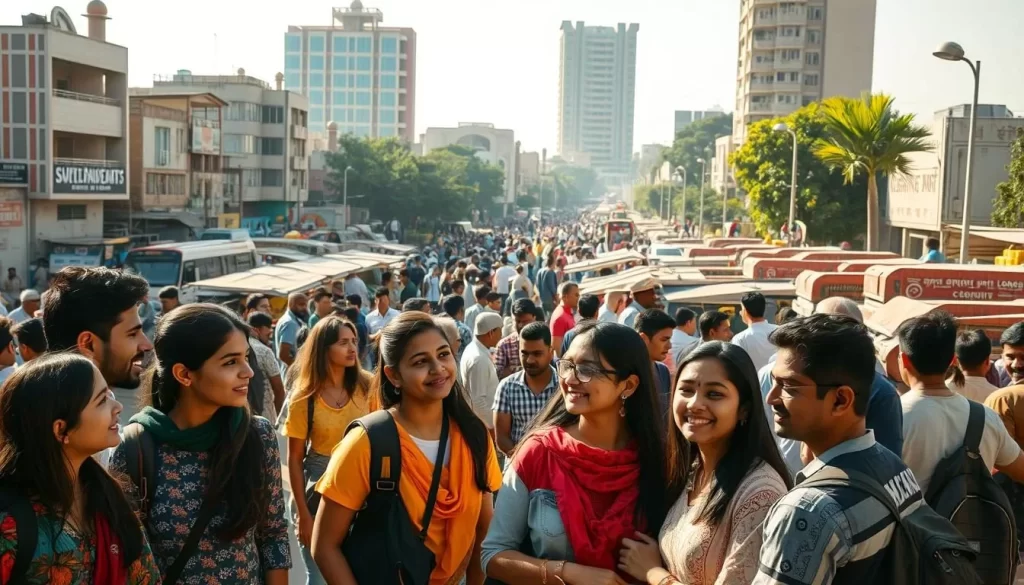
Hindi Speakers
Hindi is the predominant language spoken in Chandigarh, with 73.60% of the population using it as their primary language. This is largely due to the city’s status as an educational and employment hub, attracting people from Hindi-speaking regions. As a result, Hindi dominates the linguistic landscape, making it the most widely spoken language in the city.
Punjabi Speakers
Punjabi, being the scheduled language of Chandigarh and the official language of the neighboring Punjab state, is spoken by approximately 22.03% of the population. Despite its official status in the nearby state, Punjabi speakers form a significant minority in Chandigarh. The language plays a crucial role in the cultural identity of the city, reflecting its historical and geographical context.
Other Language Communities
The remaining percentage of the population speaks various other languages, contributing to the city’s linguistic diversity. Code-switching between Hindi, Punjabi, and English is common among residents, with many being functionally multilingual to navigate different social and professional contexts. This diversity is a reflection of Chandigarh’s cosmopolitan nature, attracting residents from across India.
You’ll find that the city’s language dynamics are influenced by migration patterns and its position as an educational and employment hub. The disparity between official language status and actual language use creates an interesting dynamic where government functions operate in English, while daily life continues in Hindi and Punjabi.
Historical Development of Languages in Chandigarh
The historical development of languages in Chandigarh is a complex process shaped by the city’s unique political and demographic changes. As a city that serves as the capital for two states, Punjab and Haryana, Chandigarh’s linguistic landscape has been influenced by significant historical events.
Formation of Chandigarh as a Union Territory
Chandigarh was formed as a Union Territory in 1966, following the Punjab Reorganization Act. This act led to the creation of Haryana from the eastern portion of Punjab, with Chandigarh designated as a shared capital. The decision to grant Chandigarh the status of a Union Territory administered directly by the central government had a profound impact on its language policies. You can observe that this unique arrangement necessitated a neutral language policy to balance the interests of both Punjab and Haryana.
The linguistic history of Chandigarh is deeply intertwined with the reorganization of Indian states along linguistic lines in the post-independence era. Prior to reorganization, the region’s linguistic landscape was predominantly Punjabi-speaking. However, subsequent migration patterns, particularly after 1966, significantly altered the demographic and linguistic composition.
Impact of the 1966 Punjab Reorganization
The pivotal year 1966 marked a significant turning point when the Punjab Reorganization Act led to the creation of Haryana from the eastern portion of Punjab. On 1 November 1966, Haryana’s newly formed state was carved out, while East Punjab’s western portion retained a majority of Punjab-speaking people and was renamed Punjab. This reorganization had a lasting impact on the language dynamics in Chandigarh.
The government’s language policies for Chandigarh were carefully crafted to balance the interests of both Punjab and Haryana while maintaining administrative efficiency. As a result, English was adopted as the sole official language, providing a neutral ground for administrative purposes.
In conclusion, the historical development of languages in Chandigarh reflects the city’s complex history and its role as a shared capital. The language policies implemented by the government have played a crucial role in shaping the city’s linguistic landscape.
Chandigarh (UT), India: Official and Widely Spoken Languages in Context
As you explore the linguistic landscape of Chandigarh, you’ll notice its distinct position within the Indian linguistic mosaic. This Union Territory’s approach to language is particularly noteworthy when compared to its surroundings.
Comparison with Neighboring States
Chandigarh’s language policy presents a fascinating contrast when compared to its neighboring states of Punjab and Haryana. While Punjab has Punjabi as its official language and Haryana has adopted Hindi, Chandigarh maintains English as its sole official language. This creates a unique linguistic buffer zone where the official language is neutral to both neighboring states’ dominant languages.
You can observe the differences in the table below, which compares the official languages of Chandigarh with its neighboring states and other Union Territories.
| Region | Official Language(s) |
|---|---|
| Chandigarh (UT) | English |
| Punjab | Punjabi |
| Haryana | Hindi |
| Delhi (UT) | Hindi, English |
| Andaman and Nicobar Islands (UT) | Hindi, English |
Unique Aspects of Chandigarh’s Language Policy
The government’s approach to language in Chandigarh reflects pragmatic considerations of serving as a shared capital while maintaining administrative neutrality. Unlike many other Union Territories that adopt multiple official languages, Chandigarh’s single official language approach represents an alternative model for managing linguistic complexity.
This distinctive language policy has implications for education, governance, and cultural identity that set Chandigarh apart from other regions in India. The decision to use English as the sole official language facilitates communication across different linguistic groups and supports the city’s role as a neutral administrative center.
Language in Education System
The education system in Chandigarh reflects the city’s linguistic diversity through its language policies. As a result, schools in Chandigarh offer instruction in multiple languages to accommodate student preferences and needs.
Medium of Instruction in Schools
You have the flexibility to choose the medium of instruction that suits you best in Chandigarh’s schools. Government schools typically offer instruction in English, Hindi, and Punjabi, creating a multilingual learning environment. While many private schools primarily use English as the medium of instruction, government schools provide more flexibility in language choice.
This approach helps in preserving linguistic diversity and prepares students for both local and broader educational contexts. For instance, a student proficient in Hindi or Punjabi can still access quality educational content and compete effectively in exams that may be conducted in English.

Textbooks and Educational Materials
Educational materials, including textbooks, study guides, and examination papers, are available in English, Hindi, and Punjabi. This ensures that you have access to study materials in your preferred language, making learning more effective.
The availability of educational materials in multiple languages is a significant advantage. It not only aids in understanding complex concepts but also helps in performing well in exams. The table below summarizes the availability of educational materials in Chandigarh’s government schools.
| Language | Textbooks | Study Guides | Examination Papers |
|---|---|---|---|
| English | Yes | Yes | Yes |
| Hindi | Yes | Yes | Yes |
| Punjabi | Yes | Yes | Yes |
By having educational materials in multiple languages, Chandigarh’s education system promotes inclusivity and diversity. This approach not only helps you navigate multiple linguistic environments but also prepares you for competitive exams and higher education opportunities that may require proficiency in English.
Language policies in education strive to balance the practical benefits of English proficiency with the cultural importance of maintaining Hindi and Punjabi language skills. As a result, you are well-equipped to handle various linguistic demands in your future academic and professional pursuits.
Language Use in Government and Administration
As you explore Chandigarh’s administrative functions, you’ll notice that English plays a crucial role in official language use. The city’s status as a Union Territory influences its language policies, particularly in government and administration.
Official Documentation and Communication
In Chandigarh’s government offices and administrative departments, English serves as the primary language for official documentation, internal communication, and formal proceedings. Government notifications, official gazettes, and legal documents are primarily issued in English. However, important public announcements may be translated into Hindi and Punjabi to ensure wider accessibility. The judiciary in Chandigarh conducts proceedings primarily in English, though provisions exist for translation services when needed.
Public Services and Language Access
Despite English being the official language, public-facing services often accommodate Hindi and Punjabi speakers through multilingual staff and translated materials. Public services strive to maintain language access for all residents, with many government offices employing staff capable of communicating in multiple languages. This pragmatic approach to language use in administration reflects the reality of serving a population where the official language differs from the most widely spoken languages.
The balance between official language requirements and practical communication needs creates a unique administrative environment in Chandigarh. You can observe this balance in action as you interact with various government services, where efforts are made to ensure that language barriers do not hinder access to essential services.
Multilingualism in Chandigarh’s Daily Life
Multilingualism is a hallmark of Chandigarh’s daily life, where language choice is often context-dependent. The city’s residents exhibit a remarkable ability to navigate between different languages, adapting their communication to suit various social settings.
Code-Switching and Language Mixing
In Chandigarh, code-switching—the practice of alternating between languages within a single conversation—is a common phenomenon, particularly in informal settings. This linguistic flexibility allows residents to convey nuanced meanings and establish social connections. You might observe that younger generations frequently incorporate English words and phrases into their Hindi or Punjabi sentences, creating a unique blend of language that reflects the city’s cultural diversity.
Language Preferences in Different Domains
You’ll notice distinct language preferences across different domains in Chandigarh. For instance, Hindi and Punjabi are predominantly used in homes and local markets, while English is more prevalent in professional settings, higher education, and formal interactions. This domain-specific language use reflects both practical considerations and the social prestige associated with different languages. The multilingual nature of Chandigarh’s population contributes to a rich linguistic environment where borrowing words and phrases across languages is commonplace.
As you explore the city, you’ll find that this linguistic flexibility is a practical response to navigating a multilingual society where different languages serve various functions in daily life.
Media and Entertainment Languages
In Chandigarh, the media and entertainment industry thrives on the city’s linguistic diversity, offering content in multiple languages. This diversity is a reflection of the city’s population, which speaks various languages, including Hindi, Punjabi, and English.
Newspapers and Print Media
The print media landscape in Chandigarh is characterized by a mix of languages, catering to different segments of the population. Major Hindi newspapers enjoy the largest circulation, serving the 73.60% of the population that speaks Hindi. Punjabi publications also have a significant presence, catering to the sizable Punjabi-speaking minority. English-language newspapers, while serving a smaller percentage of readers, remain important among professionals, academics, and government officials.
Television and Radio
Television viewing habits in Chandigarh follow the city’s linguistic preferences, with Hindi channels dominating viewership, followed by Punjabi and English programming. Radio broadcasts are available in all three major languages, with specific time slots allocated to different language programs, ensuring that there’s something for everyone.
Digital Media and Social Platforms
The digital media space in Chandigarh has further diversified language options. Social media users often post in multiple languages or use romanized versions of Hindi and Punjabi. Content creators from Chandigarh frequently produce multilingual content to reach broader audiences, reflecting the city’s comfort with linguistic diversity.
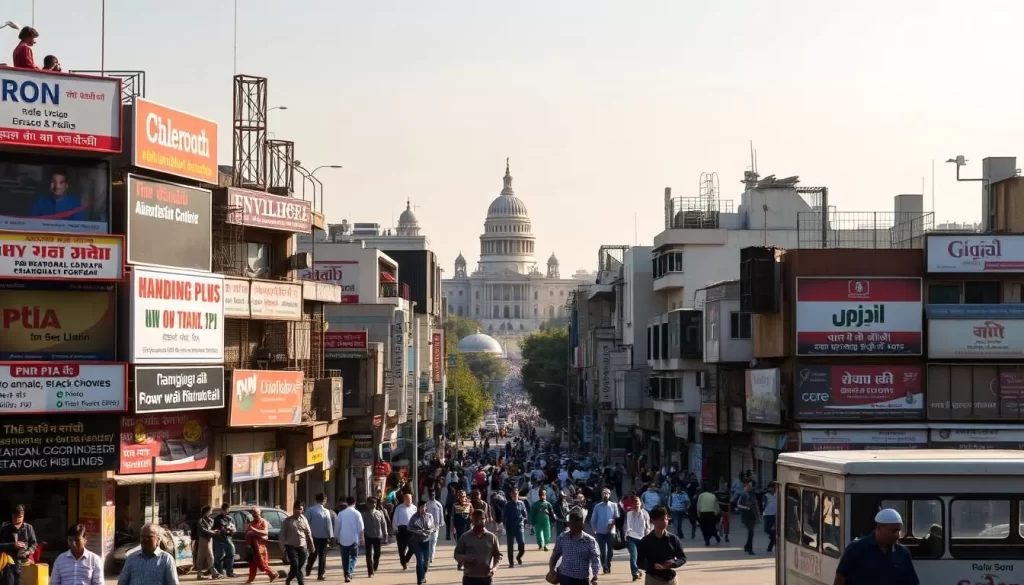
- A diverse range of newspapers, television channels, and digital content available in Hindi, Punjabi, and English.
- Major Hindi newspapers having the largest circulation, serving the majority of the population.
- Punjabi publications catering to the significant Punjabi-speaking minority.
- English-language media maintaining importance among specific demographics.
Overall, Chandigarh’s media and entertainment industry is a vibrant reflection of the city’s linguistic diversity, offering a wide range of content that caters to the needs of its multilingual population.
Language and Cultural Identity in Chandigarh
The relationship between language and cultural identity in Chandigarh is complex and multifaceted. As a city with a rich cultural heritage, Chandigarh’s identity is shaped by various linguistic influences.
Influence of Punjabi Culture
Despite Hindi being the most widely spoken language and English being the official language, Punjabi cultural influences remain strong in Chandigarh’s cultural identity. The city celebrates Punjabi festivals, music, and cuisine, creating a situation where cultural identity isn’t perfectly aligned with the linguistic majority. Many residents maintain emotional connections to Punjabi as a heritage language even if they primarily speak Hindi in daily life.
- Punjabi cultural events are an integral part of Chandigarh’s social calendar.
- The city’s cuisine is heavily influenced by Punjabi flavors and traditions.
- Punjabi music and dance are popular among the city’s residents.
Cosmopolitan Nature and Language Attitudes
Chandigarh’s cosmopolitan nature has fostered generally positive attitudes toward multilingualism, with language diversity viewed as an asset rather than a problem. The city’s population is diverse, with people from various linguistic backgrounds. Language attitudes vary across generations, with older residents often placing higher value on regional language preservation while younger people may prioritize English proficiency for career advancement.
The disconnect between cultural identity and language use creates interesting dynamics where cultural practices may be maintained even as language shifts occur across generations. This complex relationship between language and identity reflects Chandigarh’s unique position as both a planned administrative center and a cultural crossroads.
Language Policies and Planning
Chandigarh’s status as a Union Territory directly influences its approach to language planning. As a territory administered by the central government, Chandigarh’s language policies are shaped by its unique administrative status and the need to serve as the capital for two states, Punjab and Haryana, with different linguistic majorities.
Union Territory Status and Language Regulations
The decision to use English as the official language in Chandigarh serves both administrative efficiency and political neutrality. Unlike many other Union Territories that have adopted multiple official languages, Chandigarh maintains English as its sole official language while making practical accommodations for Hindi and Punjabi speakers. This approach reflects the territory’s pragmatic considerations rather than ideological commitments to particular languages.
You will find that the language regulations in Chandigarh must balance the practical needs of administration with the linguistic preferences of its diverse population. The government’s approach to language planning is designed to be inclusive, ensuring that government services remain accessible to all residents regardless of their language preferences.
Implementation and Challenges
Implementation of language policies in Chandigarh faces practical challenges, particularly in ensuring that government services are accessible to all. The pragmatic approach adopted by the government has generally helped avoid the language conflicts that have emerged in some other regions of India. However, continued efforts are needed to maintain this balance and ensure that the language policies serve the needs of all residents.
You might observe that the use of English as the official language, coupled with accommodations for other languages, provides a unique model for language policy in a multilingual context. This model can be particularly relevant for other Union Territories or regions with diverse linguistic populations.
Linguistic Landscape in Public Spaces
The visual representation of languages in Chandigarh’s public spaces provides valuable insights into the city’s language policies and practices. As you navigate through the city, you’ll notice how different languages are used in various contexts, reflecting both official policies and the practical needs of the residents.
Signage and Public Information
Official government signage in Chandigarh typically follows a trilingual pattern, with English (the official language) prominently featured alongside Hindi and Punjabi. This approach ensures that public information is accessible to all residents, regardless of their primary language. You’ll observe that road signs, government building identifications, and public notices generally maintain this trilingual approach, reflecting both official policy and practical communication needs.
For instance, a typical road sign in Chandigarh might look like this:
| Language | Example Text |
|---|---|
| English | Main Road |
| Hindi | मुख्य सड़क |
| Punjabi | ਮੁੱਖ ਸੜਕ |
Commercial and Business Language Use
Commercial establishments in Chandigarh show more variation in language use, with many businesses using Hindi and English predominantly. Punjabi appears less frequently in commercial signage, although it’s not entirely absent. The business sector tends to favor English for professional communication, reflecting both its official status and its role as a language of commerce and higher education.
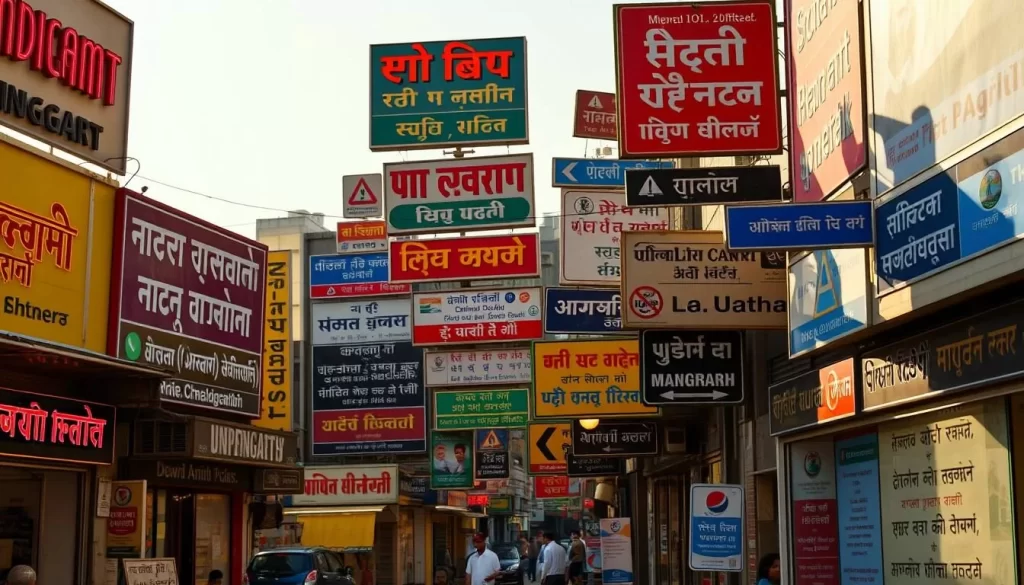
Some businesses may use a combination of languages on their signage, while others might stick to a single language. For example, a local shop might display its name in both Hindi and English, while a multinational brand might use English exclusively.
The linguistic landscape of Chandigarh thus serves as a visible manifestation of the complex interplay between official language status and actual language use in daily life. By examining the language use in public spaces, you can gain a deeper understanding of the city’s cultural and linguistic diversity.
Language Demographics and Trends
As you explore Chandigarh’s language trends, you’ll notice a complex interplay of factors at work. The city’s linguistic landscape is constantly evolving, influenced by demographic shifts, migration patterns, and socio-economic changes.
Census Data and Language Shifts
Census data over the years has revealed interesting trends in Chandigarh’s linguistic composition. Hindi speakers constitute an increasing majority, currently making up 73.60% of the population. Conversely, the percentage of Punjabi speakers, while still significant at 22.03%, has seen a relative decline over the decades. This shift reflects changing migration patterns and demographic adjustments within the city.
The data suggests that Chandigarh’s role as an educational and administrative hub attracts residents from various regions, contributing to its language diversity. The city’s appeal to students and professionals from Hindi-speaking regions has been a significant factor in the increase in Hindi speakers.
| Language | Percentage of Population |
|---|---|
| Hindi | 73.60% |
| Punjabi | 22.03% |
| Other Languages | 4.37% |
Migration Patterns and Language Impact
Migration patterns have significantly impacted Chandigarh’s language demographics. The city’s educational and employment opportunities attract people from various linguistic backgrounds, contributing to its multilingual nature. You’ll find that these migration patterns correlate with language shifts, as people from Hindi-speaking regions move to Chandigarh for better opportunities.
Intergenerational language transmission patterns also show an interesting trend. There’s a noticeable shift toward Hindi and English, particularly among families that have resided in Chandigarh for multiple generations, at the expense of Punjabi. This shift indicates the evolving linguistic preferences in the city.
These demographic trends suggest that while Chandigarh will remain multilingual, the balance between languages continues to evolve. Understanding these language shifts provides insights into broader social, economic, and cultural changes occurring within the Union Territory.
Comparison with Other Union Territories
As you explore the linguistic landscape of various Union Territories in India, you’ll notice that Chandigarh’s language policy stands out. While many Union Territories adopt multiple official languages to reflect their diverse populations, Chandigarh has chosen a different path.
Language Policies in Different UTs
The language policies across Union Territories in India vary significantly. For instance, the Andaman and Nicobar Islands recognize both Hindi and English as official languages, catering to the needs of its diverse population. Similarly, Dadra and Nagar Haveli has adopted multiple official languages to serve its community.
In contrast, some Union Territories have unique historical influences on their language policies. Daman and Diu, for example, reflects its historical connection with Portugal alongside its contemporary linguistic realities.
| Union Territory | Official Languages |
|---|---|
| Andaman and Nicobar Islands | Hindi, English |
| Dadra and Nagar Haveli | Multiple languages |
| Daman and Diu | English, Hindi, Gujarati |
| Chandigarh | English |
Unique Position of Chandigarh
Chandigarh’s unique position as a shared capital for two linguistically different states has necessitated a language policy focused on neutrality and administrative efficiency. Unlike many other Union Territories, Chandigarh’s approach prioritizes its role as an administrative center.
This comparative perspective highlights how different Union Territories have developed distinct approaches to managing linguistic diversity within similar administrative frameworks. You can observe that while some UTs embrace multiple languages officially, Chandigarh maintains a singular focus on English.
The diversity in language policies across Union Territories underscores the complexity of managing linguistic diversity in a multilingual country like India. As you consider the case of Chandigarh and other UTs, it becomes clear that each territory’s historical, demographic, and administrative contexts play a crucial role in shaping their language policies.
Challenges and Controversies in Language Use
As you explore the linguistic landscape of Chandigarh, you may notice that despite its harmonious multilingual environment, certain challenges and controversies occasionally emerge regarding language use and representation.
The city’s unique administrative status and demographic composition contribute to these complexities. One of the primary concerns revolves around language rights, particularly the status of Punjabi, which some advocate should have greater official recognition given Chandigarh’s historical role as Punjab’s capital.
Language Rights and Representation
The decision to use English as the sole official language, while pragmatic from an administrative perspective, raises questions about the representation of languages actually spoken by the majority of residents. You might find that this decision has implications for the accessibility of government services and the overall inclusivity of the city’s language policy.
- The use of English as the primary language for official purposes can create barriers for those with limited proficiency.
- Advocates for Punjabi and other local languages argue for greater recognition and use in official contexts.
- The balance between administrative efficiency and linguistic representation is a delicate one.
Debates on Language Dominance
Debates occasionally surface about language dominance in education, with advocates for different languages arguing for greater emphasis on their preferred language in school curricula. You will find that these debates often reflect broader political tensions regarding Chandigarh’s status and its relationship to Punjab and Haryana.
| Language | Speakers (%) | Advocacy Focus |
|---|---|---|
| Punjabi | 22.03% | Greater official recognition |
| Hindi | 73.60% | Prominence in education and government |
| English | N/A | Continued use as official language |
The practical implementation of language policies in courts, government offices, and public services sometimes creates accessibility challenges for residents with limited English proficiency. These ongoing discussions reflect the inherent complexity of managing linguistic diversity in a region with Chandigarh’s unique administrative status and demographic composition.
Conclusion: The Future of Languages in Chandigarh
Looking ahead, Chandigarh’s language landscape will likely be shaped by a combination of demographic, educational, and administrative factors. As the city continues to evolve, its multilingual character is expected to remain a defining feature.
You’ll find that the official language status of English will likely be retained due to its administrative utility and neutral position between Punjab and Haryana. This will continue to serve important functions in education, business, and professional advancement. The practical dominance of Hindi in daily life appears set to continue, particularly with ongoing migration from Hindi-speaking regions and intergenerational language transmission patterns favoring Hindi.
Educational resources will continue adapting to this multilingual reality, with study materials, exam papers, and test series becoming increasingly available in multiple languages to serve diverse student needs. Digital platforms offering free tests, detailed solutions, and comprehensive study materials in multiple languages will become increasingly important for students preparing for competitive exams. You can expect educational initiatives like supercoaching programs and skill academies to navigate language preferences to effectively serve Chandigarh’s diverse student population.
The crore-rupee education industry will continue developing multilingual approaches, recognizing that language flexibility is essential in a region where official language, majority spoken language, and languages of cultural heritage don’t perfectly align. While language shifts will occur naturally through demographic changes and practical considerations, Chandigarh’s unique position as a planned city and dual capital ensures that multilingualism will remain a defining characteristic of its linguistic future.
As you consider the future of languages in Chandigarh, it’s clear that the city’s linguistic landscape will continue to evolve while maintaining its fundamentally multilingual character. With the ongoing development of educational resources and digital platforms, students will have access to a wide range of study materials and test series to aid in their preparation for competitive exams.


